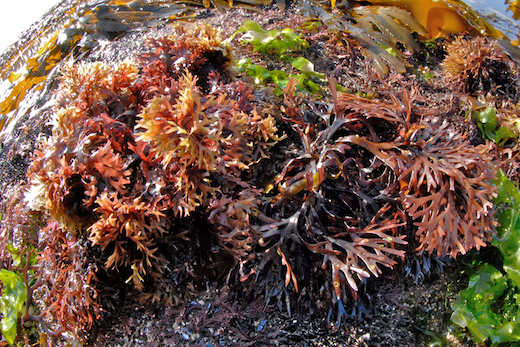
http://oceanlink.info/biodiversity/seaweeds/seaweeds.html
Seaweed is a Algae, which means it is in the Protista kingdom. This means that seaweed is neither plants or animals. Seaweed is not listed with plants because seaweed does not have the same features as plants or animals. A seaweed have four mains parts of its structure. the hold-fast is the roots of the seaweed that holds it planted into the ground. If the hold-fasts werent there, then seaweed would be floating everywhere. The stipe is a term they use for the stem, or stalk of the seaweed. The stipe supports the seaweed and it can be stiff, gas filled, flexible, long, short, or not there at all. There are leaves on a seaweed but the correct name for it is the Blades. The blades work as leaves though. They are used for photosynthesis, and reproduction use. The final part of a seaweed is the Float. The float is a gas filled bubble in the seaweed that is used to help the photosynthesis factor.
Why are seaweed important in an ecological role? Its because seaweed is used for photosynthesis and it is a food source. They even work as a home for some species of marine animals. Even though they are important in the ecological factor, they also encounter ecological stress. Stress involved, the seaweed drying up from low water levels, and
weather conditions. Cold conditions can freeze seaweed. Seaweed can be sexually reproductive by male and female cells joining. These cells are called gametes. Seaweed can be asexually produced but a fragment of the seaweed breaking off but continue to live on to become a whole new seaweed.
weather conditions. Cold conditions can freeze seaweed. Seaweed can be sexually reproductive by male and female cells joining. These cells are called gametes. Seaweed can be asexually produced but a fragment of the seaweed breaking off but continue to live on to become a whole new seaweed.
Seaweed are characterized under 3 groups. The green algae, the brown algae, and the red algae. These are different types of seaweed but they all work in the same ways.
There are human benefits from seaweed. Seaweed is an edible substance and the Japenese has used it. Seaweed can be used for medicinal reasons like treating burns. Seaweeds also has many cancer fighting agents that will hopefully in the future fight off cancer. They are also used in tooth paste and other things.
“Red seaweed Chondrus crispus, photo from The Seaweed Site”
“Green seaweed Ulva lactuca, photo from The Seaweed Site”
Himanthalia_buttons.png
PHOTOSYNTHESIS OF SEAWEED
In class we did a lab that involved using pine sticks that still had green points, beakers, water, and baking soda. We put the little stick of pine in a glass tube and we filled it with water. We then filled the beaker with water and put a pinch of baking soda in. Then we quickly tipped the tube of water with the pine inside upside down, not letting much water out, and turned on a light below it. As it sat in the water and light, bubbles formed on the pine needles of the pine stick and the bubble rose because photosynthesis was in action.
Sources
“For most of history, man has had to fight nature to survive; in this century he is beginning to realize that, in order to survive, he must protect it.” ― Jacques-Yves Cousteau



No comments:
Post a Comment